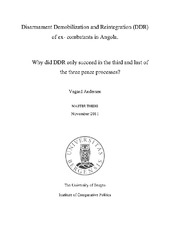Disarmament Demobilization and Reintegration (DDR) of ex-combatants in Angola. Why did DDR only succeed in the third and last of the three peace processes?
Master thesis
Permanent lenke
https://hdl.handle.net/1956/9752Utgivelsesdato
2011-11Metadata
Vis full innførselSamlinger
Sammendrag
This thesis is a qualitative case study comparing the three Angolan peace processes, the Bicesse Accords, the Lusaka Protocol and the Luena Memorandum of Understanding. The thesis seeks to explain why Disarmament, Demobilization and Reintegration (DDR) only succeeded in the third and last of the three peace processes. On the basis of the research question the thesis discusses changes in the political environment between the two failed attempts and the last one that succeeded. The approach I have used is to design a list of five criteria considered important for a successful DDR process and analyzed the empirical data in the light of these criteria: 1) Realistic time frame. 2) Creation of a new unified army. 3) Regional approach to weapons control. 4) The role of the UN. 5) Power-sharing. The civil war in Angola took place from 1975 to 2002 and was predominantly fought between the Popular Movement for the Liberation of Angola (MPLA) and the União Nacional para a Independência Total de Angola (UNITA), for the total control of Angola and its vast natural resources. Questions that keep arising in the aftermath of a conflict are how long will the fragile peace last and what kind of peace-building initiatives will be effective? DDR of former excombatants is a political process that is built on mutual trust and will by the parties. DDR is the first step in the transition from war to peace. My findings indicate that the government’s military victory over the UNITA, crowned with the killing of UNITA leader Jonas Savimbi, finally silenced the guns in the three decades long civil war. Sustainable peace became possible when the biggest spoiler of the DDR process was eliminated and this event unfolded a chain of positive reactions that was not present during the two failed attempts. The MPLA government won the war against the UNITA, which led to the success of criterion 2; completion of the reintegration of UNITA ex-combatants into a new unified army. But prior to this, a regional approach to weapons control (criterion 3), achieved by the MPLA government during the final war (1998-2002), limited UNITA’s military manoeuvrability and weapons supply. The impact that the end of the cold war made, together with the end of the conflict in South Africa were also additional “outside” factors. The solution of criterion 3, which put a stop to cross-border arms flows to UNITA, reduced Savimbi’s spoiling capacity. This criterion seems to have been particularly important for making peace possible during the third and last DDR process.
